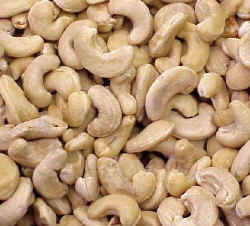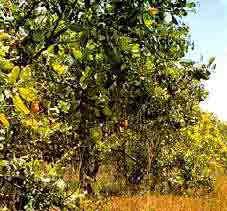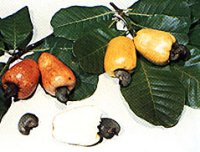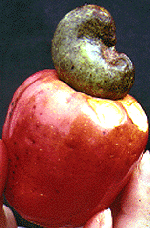|
|
 Raw Cashew Nuts
- Are they Really Raw? Raw Cashew Nuts
- Are they Really Raw?
by John KohlerCashew nuts are one of my favorite nuts on this
planet. Unfortunetly, most cashew nuts labeled "raw cashew nuts" are
not truly "raw". They have been heat processed in order to remove the
delicious nut from the toxic shell.
You may ask why they label it "raw".. I have often thought
of the very same questions. Most companies label it "raw" because to them,
the nut has "not" been processed, ie: roasted. Although in the process of
removing the actual shell, the nut has been very processed...usually steamed and boiled in
oil! So until recently I have pretty much avoided purchasing raw cashew nuts.
I have been enjoying in-shell macadamia nuts, which are my all time favorite nut.
When purchasing mac nuts, its important to purchase them in the shell. Once the nut
has been out of the shell, many go rancid.
This article will explain more about the cashew nut, and cashew
apple, the fruit of the nut, as well as its origin, and nutrient value.
 The cashew, Anacardium occidentale L., belongs to the Anacardiaceae
or cashew family. Two related plants in this family are the mango tree and pistachio tree. The cashew, Anacardium occidentale L., belongs to the Anacardiaceae
or cashew family. Two related plants in this family are the mango tree and pistachio tree.
The cashew tree is native to South America where it flourishes in
Brazil and Peru. In the sixteenth century, Portuguese traders introduced the tree to India
where it has more recently become an important export crop equal to that of Brazil. Other
countries that grow and export cashews include Sri Lanka, China, Malaysia, the
Philippines, Thailand, Colombia, Guatemala, Venezuela, the West Indies, Nigeria,
Mozambique, Tanzania, and Kenya. The United States is the largest importer of cashew nuts.
The cashew tree is a hearty, fast-growing evergreen with an
umbrella-like canopy. Under favorable conditions it may reach a height of forty to fifty
feet. The tree has a rather messy look with it's gnarled stem and crooked branches. Lower
branches rest near the ground and may root, further augmenting it's spreading form. The
leaves of the cashew tree are four to eight inches long and two to three inches wide. Its
aromatic flower clusters are a yellowish pink.
 Cashew trees produce both a fruit
("apple") and a nut, and a valuable oil can be drawn from the nut shell. After
the cashew flower blooms, a nut forms. The apple later swells between the nut shell and
the stem. It takes two months for the cashew apple to ripen. When harvested, the apple can
only keep for twenty-four hours before it begins to ferment. Although the fruit can be
used for making many typical fruit products (jellies, jams, juice, wine and liquor), the
apple is often discarded, in pursuit of the nut. If processed and stored properly, the
cashew nut can be kept for a year or longer. Technically, the
actual nut is the thick-shelled seed. The outer shell (coat) of the seed contains the
poison oak allergen urushiol, and may cause dermatitis in hypersensitive people. Cashew trees produce both a fruit
("apple") and a nut, and a valuable oil can be drawn from the nut shell. After
the cashew flower blooms, a nut forms. The apple later swells between the nut shell and
the stem. It takes two months for the cashew apple to ripen. When harvested, the apple can
only keep for twenty-four hours before it begins to ferment. Although the fruit can be
used for making many typical fruit products (jellies, jams, juice, wine and liquor), the
apple is often discarded, in pursuit of the nut. If processed and stored properly, the
cashew nut can be kept for a year or longer. Technically, the
actual nut is the thick-shelled seed. The outer shell (coat) of the seed contains the
poison oak allergen urushiol, and may cause dermatitis in hypersensitive people.
 There is a toxic resin inside the shell layer. If the shell is not opened
properly, the resin will get on the cashew nut, making it inedible. Most companies steam
the shell open at a high temperature, thus cooking the cashew nut inside. A certain
nut producer in Indonesia uses a special technique with specially-designed tools (without
using any heat at all) to open the shell cleanly every time without ever exposing the
cashew nut to the resin. The raw cashews are much sweeter, tastier, and nutritious than
their cooked counterparts. There is a toxic resin inside the shell layer. If the shell is not opened
properly, the resin will get on the cashew nut, making it inedible. Most companies steam
the shell open at a high temperature, thus cooking the cashew nut inside. A certain
nut producer in Indonesia uses a special technique with specially-designed tools (without
using any heat at all) to open the shell cleanly every time without ever exposing the
cashew nut to the resin. The raw cashews are much sweeter, tastier, and nutritious than
their cooked counterparts.
Many people avoid cashew nuts because of their high fat content,
though they are lower in total fat than almonds, peanuts, pecans, and walnuts. Cashew
provide essential fatty acids, B vitamins, fiber, protein, carbohydrate potassium, iron,
and zinc. Like other nuts, cashews have a small percentage of saturated fat; however,
eaten in small quantities cashews are a highly nutritious food.
There are only a few places that sell the truly RAW cashew
nuts. I recommend the following place: The The Raw Food World. |
